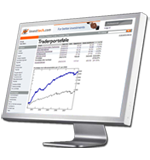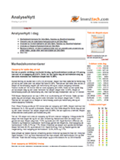The most important buy and sell signals - how well do they perform?
Published 29 September 2023
Based on nearly 200,000 signals in stocks on the Nordic stock exchanges in the period from 2008 to 2020, we have studied to what extent key signals in technical analysis have proven accurate. This article provides an overview of our most significant research results. The main conclusion is that stocks have largely risen after buy signals and fallen after sell signals, as the theory suggests.
Investtech's systems are based on research dating back to 1994. Several of our projects are supported by the Norwegian Research Council. The research is built on principles such as mathematical pattern recognition, statistical optimization, and behavioural finance. We use algorithms to automatically identify buy and sell signals. There are four main signal groups within technical analysis. In addition, we also examine return following insider trading signals.
1. Stocks in a rising trend (buy) and stocks in a falling trend (sell)
Trends are one of the most important indicators in technical analysis. According to technical analysis theory, stocks in rising trends continue to rise, while stocks in falling trends continue to fall. Research conducted by Investtech shows that this holds true.
2. Price far above last resistance (buy) and far below last support (sell)
Support and resistance can be used to find good buy and sell levels. When the price breaks upwards through a resistance level, it triggers a buy signal. When it breaks downwards through a support level, it triggers a sell signal. The price may then move several percentage points in a short time.
3. RSI above 70 (buy signal) versus RSI below 30 (sell signal)
Momentum has proven to be a strong indicator of future price development.
4. Rectangle patterns
A rectangle formation indicates consolidation in the market. The longer the formation develops, the more pressure builds among investors. When the formation is broken, it is often followed by a significant price movement in the same direction.
5. Insider buying (buy signal) and insider selling (sell signal)
Analysis of insider transactions is Investtech's alternative to fundamental analysis. When a person in the company's board or management buys stocks, it is a signal that they believe the stock is cheap. Insider selling is considered a signal that the stock is expensive or that the risk is high.
Below, you will find research results for each of the five signal types, but first, a brief explanation of how to interpret the results.
How to interpret the tables and charts
When the systems detect a new technical signal, we set day number 0 to be the day the signal was triggered. This is on the far left in the charts below. We have then studied how these stocks have developed in the subsequent 66 trading days, equivalent to three months.
The charts show relative figures in relation to benchmark. For example, if a stock on the Oslo Stock Exchange increased by 5.0 per cent in three months, while benchmark increased by 3.5 per cent, the relative return is +1.5 percentage points.
The blue line represents stocks with buy signals. If it rises, it means that the stocks with buy signals increased more than the market in the same period. The red line represents stocks with sell signals. If it falls, it means that the stock with the sell signal performed weaker than the market in the same period.
The shaded areas are an estimate of uncertainty. The narrower they are, the less uncertainty in the chart.
When the blue line rises and the red one falls, along with with narrow shaded areas, we have strong signals. It has then been advantageous to buy the stocks with buy signals and sell those with sell signals.
For a rising trend, the chart shows a relative increase of 1.5 percentage points, as seen in the blue line in the chart below. This is for a period of 66 days, equivalent to a quarter of a year. Repeated four times over a year, and with the compounding effect, it results in an annual excess return of 6.5 percentage points, as shown in the table.
However, this is relative to benchmark, which increased by 9.7 per cent annually, so the annual return for stocks in a rising trend has been an average of 16.3 per cent per year.
You can also experiment a bit and, for example, repeat it over ten years. This results in a return of 352 per cent for stocks in a rising trends, 152 per cent for benchmark, and 40 per cent for stocks in falling trends.
1. Stocks in a rising trend (buy) and stocks in a falling trend (sell)
Nordic markets combined: 35,097 buy signals, 23,289 sell signals in the period 2008-2020:
| Nordic markets, annualised (based on 66-day figures) | Return | Benchmark | Diff v average benchmark | Diff v benchmark in same period |
| Buy signals | 16.3 % | 9.7 % | 6.4 %p | 6.5 %p |
| Sell signals | 3.4 % | 9.2 % | -6.4 %p | -5.8 %p |
%p = percentage point
Figure: Nordic markets combined, medium long term, development relative to benchmark in same period.
- More details are available (in Norwegian) in the research report here (Professional subscription required).
- See also this research article here for results for the period 2020-2022.
2. Price far above last resistance (buy) and far below last support (sell)
Nordic markets combined: 32,531 buy signals, 17,487 sell signals in the period 2008-2020:
| Nordic markets, annualised (based on 66-day figures) | Return | Benchmark | Diff v average benchmark | Diff v benchmark in same period |
| Buy signals | 18.2 % | 8.1 % | 8.4 %p | 10.1 %p |
| Sell signals | 4.5 % | 11.6 % | -5.3 %p | -7.1 %p |
Figure: Nordic markets combined, medium long term, development relative to benchmark in same period.
- More details are available (in Norwegian) in the research report here (Professional subscription required).
3. RSI above 70 (buy signal) versus RSI below 30 (sell signal)
Nordic markets combined: 35,864 buy signals, 24,920 sell signals in the period 2008-2020:
| Nordic markets, annualised (based on 66-day figures) | Return | Benchmark | Diff v average benchmark | Diff v benchmark in same period |
| Buy signals | 17.1 % | 9.7 % | 7.3 %p | 7.4 %p |
| Sell signals | 6.1 % | 11.7 % | -3.8 %p | -5.7 %p |
- More details are available (in Norwegian) in the research report here (Professional subscription required).
4. Rectangle patterns
Nordic markets combined: 3,368 buy signals, 2,677 sell signals in the period 2008-2020:
| Nordic markets, annualised (based on 66-day figures) | Return | Benchmark | Diff v average benchmark | Diff v benchmark in same period |
| Buy signals | 19.8 % | 10.8 % | 10.0 %p | 9.0 %p |
| Sell signals | 4.3 % | 10.9 % | -5.5 %p | -6.6 %p |
Figure: Nordic markets combined, medium long term, development relative to benchmark in same period.
- More details are available (in Norwegian) in the research report here (Professional subscription required).
5. Insider buying (buy signal) and insider selling (sell signal)
Nordic markets combined: 9,837 buy signals, 5,158 sell signals in the period 2008-2020:
| Nordic markets, annualised (based on 66-day figures) | Return | Benchmark | Diff v average benchmark | Diff v benchmark in same period |
| Buy signals | 19.0 % | 10.9 % | 8.7 %p | 8.1 %p |
| Sell signals | 8.0 % | 9.7 % | -2.3 %p | -1.8 %p |
- More details are available (in Norwegian) in the research report here (Professional subscription required).
Verfasst von

Forschungs- und Analysechef
Investtech
"Investtech analysiert die Psychologie des Marktes und macht Ihnen täglich konkrete Tradingvorschläge."

Partner & Senior Advisor - Investtech
Die Anlageempfehlungen werden von Investtech.com AS ("Investtech") ausgearbeitet. Investtech übernimmt keine Haftung für die Vollständigkeit oder Richtigkeit der jeweiligen Analyse. Ein etwaiges Engagement aufgrund der aus den Analysen resultierenden Empfehlungen/Signale erfolgt zur Gänze für Rechnung und Risiko des Anlegers. Investtech haftet nicht für Verluste, die sich direkt oder indirekt infolge der Nutzung von Investtechs Analysen ergeben. Angaben zu etwaigen Interessenkonflikten gehen stets aus der Anlageempfehlung hervor. Weitere Informationen zu Investtechs Analysen finden Sie unter disclaimer.
Die Anlageempfehlungen werden von Investtech.com AS ("Investtech") ausgearbeitet. Investtech übernimmt keine Haftung für die Vollständigkeit oder Richtigkeit der jeweiligen Analyse. Ein etwaiges Engagement aufgrund der aus den Analysen resultierenden Empfehlungen/Signale erfolgt zur Gänze für Rechnung und Risiko des Anlegers. Investtech haftet nicht für Verluste, die sich direkt oder indirekt infolge der Nutzung von Investtechs Analysen ergeben. Angaben zu etwaigen Interessenkonflikten gehen stets aus der Anlageempfehlung hervor. Weitere Informationen zu Investtechs Analysen finden Sie unter disclaimer.


 Oslo Børs
Oslo Børs Stockholmsbörsen
Stockholmsbörsen Københavns Fondsbørs
Københavns Fondsbørs Helsingin pörssi
Helsingin pörssi World Indices
World Indices US Stocks
US Stocks Toronto Stock Exchange
Toronto Stock Exchange London Stock Exchange
London Stock Exchange Euronext Amsterdam
Euronext Amsterdam Euronext Brussel
Euronext Brussel DAX
DAX CAC 40
CAC 40 Mumbai S.E.
Mumbai S.E. Commodities
Commodities Currency
Currency Cryptocurrency
Cryptocurrency Exchange Traded Funds
Exchange Traded Funds Investtech Indices
Investtech Indices


